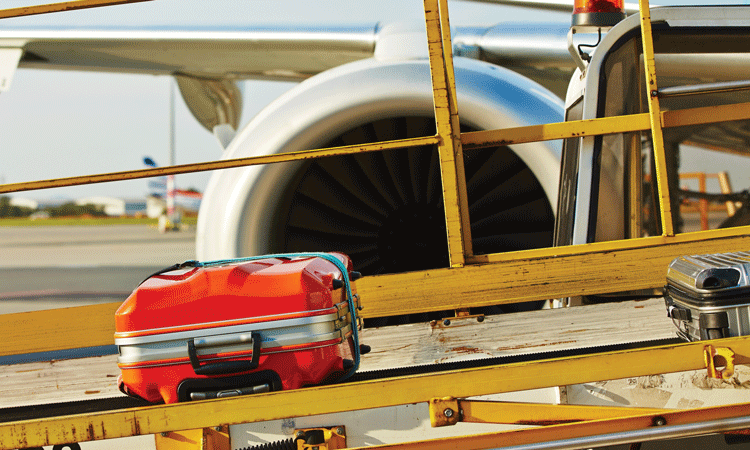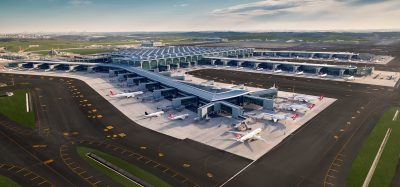IATA’s keeping baggage on track
- Like
- Digg
- Del
- Tumblr
- VKontakte
- Buffer
- Love This
- Odnoklassniki
- Meneame
- Blogger
- Amazon
- Yahoo Mail
- Gmail
- AOL
- Newsvine
- HackerNews
- Evernote
- MySpace
- Mail.ru
- Viadeo
- Line
- Comments
- Yummly
- SMS
- Viber
- Telegram
- Subscribe
- Skype
- Facebook Messenger
- Kakao
- LiveJournal
- Yammer
- Edgar
- Fintel
- Mix
- Instapaper
- Copy Link
Posted: 16 October 2015 | Andrew Price | No comments yet
In June 2013, there were several new resolutions for baggage that appeared in the IATA Passenger Services Conference Resolution Manual. One is a brief text that describes baggage tracking, but it is set to make big changes in the industry. Resolution 753 packs a lot into a small space. The resolution will become effective from June 2018 and places obligations on IATA members to track bags into and out of certain processes. Andrew Price, IATA’s Head of Airport Operations, explains more.


Why track bags into and out of a process? Baggage processes normally involve changes in custody. Whilst the responsibility for the carriage of the bag ultimately and always is with the airline (who have the contract with the passenger), the actual baggage processing is seldom in their control – except when the bag is on the aircraft and few bags are mishandled at 30,000 feet. This means that in order to really manage baggage performance, it is necessary to monitor the changes in baggage custody as the bag moves through its journey. Only by doing that can we develop an accurate view on performance metrics, such as mishandling.
Resolution 753 will mean different things to different stakeholders, and especially as each stakeholder is responsible for different parts of the overall baggage delivery. The airlines, airports and the ground handers will each have a different perspective on how the resolution impacts them.
Airlines
The ultimate bearer of the responsibility for delivering the bag to the passenger is the airline who has a number of interests in the tracking information provided by Resolution 753, including:
Loading
Some areas enforce baggage reconciliation as a legal requirement, and some do not. Resolution 753 does not make reconciliation obligatory for all, but does state that the delivery of the bag to the aircraft is recorded. This can be a simple license plate record for the bags on a flight, but is infinitely more useful when matched to baggage messages so that the bag is known to be on the right flight.
Transfers
The most common baggage mishandling is during transfers. Airlines know which bags to expect, as their own Departure Control System is sending the messages to sort and load the bag at the airport of transfer. What they often miss, especially for interline journeys, is the knowledge that a bag is actually available to be transferred at the airport. By recording the delivery of the bag into an airline system (in this case, the system the airline is using to transfer the bags) the airline can get an accurate picture of how their transfers will progress. This will reduce delays due to waiting for bags that are expected to be seen, but were never actually loaded onto the inbound flight.
Arrivals
There is no closure to a baggage journey today. When a passenger makes a claim, the airline may be able to show that the bag was loaded on the inbound flight from a Baggage Reconciliation System record, but what happened to that bag between the time the aircraft arrived and the time of the claim is unknown. Recording the bag onto the arrival reclaim allows certainty that the bag was delivered to the arrivals hall. If there is a claim for a bag that was delivered, then it is reasonable to expect that there will be a similar looking bag left behind – as the only possibility in this instance is that the wrong bag was collected by another passenger.
In any of the aforementioned situations, using this information to tell the passenger that their bag is loaded improves customer service too. There is even a possibility to make customer service differentiations by telling passengers which reclaim their bag is on – rather than the common split between bags based on class of travel – as bags often travel with a priority status whilst the passenger may not.
Proration
Proration is the process of sharing the costs for any claim arising from mishandling between the airlines responsible for carriage of the passenger. If an airline can demonstrate that another party in the journey is wholly responsible for the mishandling, then the proration is at 100% – so the ‘guilty’ party pays the cost of the mishandling. This is a very effective way of ensuring that the parties responsible for mishandling take responsibility, whilst at the same time rewarding those who perform better by enabling the accurate sharing of costs.
Ground handlers
Ground handlers are contracted by the airline to deliver baggage services, often for the entire journey from acceptance to delivery and including any exceptions that need to be handled. The handler is likely to be the party responsible for any physical scanning of the baggage tag, unless the airport installs automatic readers to do this.
General performance
Knowing where, when and how many bags you are physically moving is useful for performance management. When you add to this picture the current development of standard service level benchmarks within IATA for use by airlines, airports and ground handlers then baggage tracking becomes very interesting to ground handlers wishing to demonstrate their performance.
Accurate billing
Transparency on costs and billing is a common theme, and having a scan of every bag allows accurate billing to be undertaken.
Improved customer experience
Ground handlers are often responsible for several parts of the baggage and passenger operations that interlink with each other. Where approved by airlines, the ground handler may be able to provide additional information to the passenger – for instance, at the gate if the handler is also providing passenger agents as a service to the airline. The provision in the resolution for sharing information on tracking events also means that a ground handler can offer a proactive service – if a flight is late inbound and the bags need some help to make their connections, then this can be offered as a service.
Improved operations
Often a ground handler is responsible for the loading of the baggage on an outbound flight. Being able to identify when all available bags are actually loaded and then release the loading team to other tasks allows the operation to be more efficient.


Resolution 753 will help identify every bag during different phases of the baggage chain, thereby reducing the risk of baggage going missing
Airports
Airports are a major stakeholder in the baggage journey, and their reputation is often aligned to the baggage performance at the airport. There are several areas where the tracking data can be useful to airports, including:
Providing a better customer experience
Airport applications on smartphones are an excellent way for an airport to provide timely information to passengers, plus to allow a relationship to be established between the airport and the passenger. Many passengers have the application of their ‘home’ airport installed. The airport can offer a service where the passenger scans their bag tag receipt and then receives information on their bag, in exactly the same manner as the airlines provide.
More accurate and transparent charging
Where airlines pay a separate baggage charge to the airport, the airport can identify exactly the number and route for bags that are being handled.
Improved performance
By comparing the baggage messages received by the Baggage Handling System (BHS), and the aircraft loading records, airports can develop a better idea of their own outbound baggage performance. The same can be applied to transfer baggage, and it is even easier to start to get accurate first and last bags times for arrivals claims. With these three metrics, an airport starts to have a good picture on how their infrastructure is being used to handle bags.
Implementation
One of the big questions is how will the industry implement Resolution 753?
There are questions about infrastructure demands and costs. Many providers of BRS systems are already involved in preparation for Resolution 753, as they attend the IATA Working Group that has created the resolution. There are many implementation patterns that could be adopted, from simple license plate scanning and recording at key points to full matching with the existing baggage messages. The baggage message route provides the most data to support decision-making and information systems, but then there are associated messaging costs to be incurred. Each use case will need to be evaluated. As an example, an airport might decide to measure first bag/last bag times based on an arrivals inject scan of the baggage tags, and match this to the inbound aircraft times to ‘guess’ at the flight to which the bags belong. Other airports without clear separation between flights assigned to a reclaim would need more information to know which flight a particular bag belongs to.
There is also a question of scanning technology to be used. Scanning with an automatic barcode scanning array would reduce the number of staff needed, but might not capture every bag. Handheld scanning would capture every bag if the staff scanning were effective. There may also be options to capture data without actually scanning individual bags, and someday we may live in the world of RFID-based scanning, which would seem to be both efficient and cost effective.
The future
Airlines, airports and ground handlers are just starting to develop plans for Resolution 753 compliance, but the future is already being considered. The first area that is being examined is that of prorates, where the tracking information could be used to automatically settle proration between airlines for baggage claims. IATA is currently working on a tool that will help the industry in this area, and tracking evidence will be incorporated into the tool when available.
There is also an investigation into how pervasive scanning can change the baggage handling landscape, as it may one day be possible to have baggage tags without human readable information, which would open opportunities to enable semi-permanent baggage tags, removing the need to print anything and eliminating process steps at baggage acceptance.
To be involved in IATA’s baggage activities, please email [email protected] and we will be happy to send details on the upcoming IATA Baggage Working Group meetings.
IATA Resolution 753
The provisions of this resolution shall apply with effect from 1 June 2018.
IATA members shall maintain an accurate inventory of baggage by monitoring the acquisition and delivery of baggage.
Purpose
Accurate baggage inventories will:
- Prevent and reduce mishandling by determining custody of every bag during different phases of baggage chain
- Increase passenger satisfaction, as mishandling is reduced
- Reduce the possibility of baggage fraud by closing the baggage journey
- Enable exceptions to be detected where baggage is delivered to a party, but not processed further
- Speed up reconciliation and flight readiness for departing flights
- Help measuring compliance to SLAs
- Provide evidence to an automatic interline proration process.
Member Obligations Members shall be able to:
- Demonstrate delivery of baggage when custody changes
- Demonstrate acquisition of baggage when custody changes
- Provide an inventory of bags upon departure of a flight
- Be capable of exchanging these events with other airlines as needed. The minimum set of custody changes shall be:
- Delivery of the bag to the passenger (delivery is by the handler, acquisition is by the arrivals facility, such as an arrivals belt, the passenger’s home, etc.)
- Delivery of the bag to the aircraft (delivery is by the handler; acquisition is by the flight)
- Delivery of the bag to an airline system (delivery is by the handler; acquisition is by the airline system).
References:
- IATA Resolutions Manual: RP 1800 and RP 1740
- A4A TPM RP30.49 and Resolution 30.35




















